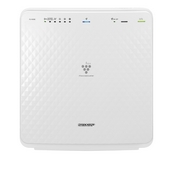Air Purifier For Mold
An air purifier can be a great help if you have mold allergies. Air purifiers filter mold spores and other allergens out of the air to help stop allergies. They also help to prevent mold growing in the future.When buying an air purifier the key things to consider are:
- Volume of air cleaned per hour
- Filter replacement
- Power usage
- Noise level

Types Of Air Purifiers
The main types of air purifiers are:- HEPA
- Activated Carbon (activated carbon is often included as a pre-filter in HEPA air purifiers)
- Ionizers
- UV (ultraviolet light)
- Ozone Generators
Best Air Purifier For Mold
The best type of air purifier for mold problems is usually one with a HEPA filter and an activated carbon pre-filter. HEPA filters capture 99.97% of 0.3 micron particles and an even higher percentage of larger particles. Mold spores are usually about 1-20 microns so the HEPA filter is perfect for filtering mold spores out of the air.The activated carbon pre-filter also removes mold odors since it can absorb VOCs and the MVOCs mold produces.
Air Purifiers Help With Mold Spores In The Air
If you have a mold problem in your home your first step should always be to have the mold removed. Sometimes people buy air purifiers to get rid of mold, but air purifiers won't kill the mold that's already growing on surfaces. Air purifiers do remove mold from the air though.Even after you've had a mold problem fixed there will always still be many mold spores left over in the air. Mold spores are continually blowing in from the outside too. And of course it's almost impossible to get rid of every little bit of mold in your home, and even little specks of mold growth put spores into the air.
But running an air purifier in your home will minimize airborne mold spores and ensure that the air you breathe is as clean and healthy as possible. Air purifiers are designed to be run 24 hours a day so that the air will always be kept clean. They use very little power and are usually very quiet so you can easily run them all the time. Air purifiers also give you instant results since they can totally clean all the air in a room within minutes of being switched on.
Air Purifiers Help Prevent Mold
Although air purifiers usually won't kill the mold growing in your home, they do help to prevent more mold growing in the future. Mold colonies grow from mold spores which land on damp surfaces. Since air purifiers remove mold spores in the air, this helps to prevent new mold colonies from growing. So air purifiers can also be a great long term help with mold.Air Purifiers Help With Pollen, Dust, Dust Mites, Pets, Bacteria And More
Besides removing mold spores, air purifiers can also remove dust, pollen, pet dander, dust mite feces, bacteria, smoke, VOCs and some can even remove viruses. So not only will a purifier help with mold allergies but they also help with any other allergies you might have from things in your home's air.An air purifier also helps with asthma and reduces the amount of dust in a room, so you don't need to dust and vacuum as often.
Buying An Air Purifier
Air Purifiers and Room Size
The air purifier you should buy depends on the size of the room where you plan to use it. Make sure to check air purifiers for their recommended room size. It should be the same or greater than the room where you are going to run the purifier.The size of the room recommended for an air purifier is based on how fast the purifier can clean the air. For example, experts recommend that an air purifier should be able to clean all the air in a room at least twice per hour, and some recommend six air changes per hour (ACH). Generally, the more ACH the better.
Often an air purifier will have listed the volume of air cleaned at different fan speeds in cubic feet per hour, or cubic feet per minute.
Clean Air Delivery Rate (CADR)
Another measure of how quickly and how well an air purifier cleans the air is clean air delivery rate (CADR). CADR tells you the volume of air that an air purifier cleans of a certain particle per minute. It is found by multiplying the air flow in cubic feet per minute by the percentage of particles removed.CADR rates for dust are between 10 and 400, for tobacco smoke are between 10 and 450, and for pollen between 25 and 450. Consumer Reports rates CADR scores above 350 as excellent, and below 100 as poor.
Air Purifier Power Usage
Another consideration when buying an air purifier is how much electricity will it use. Usually the faster an air purifier can clean the air, the more power it will use. So purifiers for bigger rooms generally use more electricity. However, purifiers do vary in efficiency, with some being able to clean more air for the same amount of power.Fortunately though, most air purifiers use very little power, often less than 10 watts on low, so you can run them continually without having to worry about the electricity bill.
Air Purifier Filter Replacement
The other operating cost, besides electricity, is filter replacement. This cost depends on how often you have to change the filter and how much a new one costs.HEPA filter life can often range from about six months to five years. Sometimes they can be washed or cleaned and reused. When you are buying an air purifier, make sure to check how long the filter lasts and how much new filters cost.
Air Purifier Noise Levels
The final consideration is how noisy the air purifier is. Again, the noise level can be a trade-off for how quickly the purifier can clean air. The amount of noise the air purifier makes in decibels (dB) should be listed. Most air purifiers are very quiet though, often virtually silent on low speed.Descriptions of Air Purifier Types
HEPA Air Purifiers
HEPA (high efficiency particulate air) filters are paper-like filters which remove at least 99.97% of particles 0.3 microns in size, and an even higher amount of larger particles. Since mold spores are usually about 1-20 microns in size, HEPA filters are ideal for filtering and trapping mold spores from the air. Once mold spores are trapped in the HEPA filter they won't grow into mold colonies since there isn't enough moisture. Often the filters also have an antimicrobial coating.Not only will a HEPA filtered air purifier reduce your mold allergies but they can also remove other allergens from your home's air, like pollen, dust mite feces, and pet dander. This helps improve your home's indoor air quality so that the air you breathe is as clean as possible and your home healthier.
When you are looking for a HEPA air purifier make sure you purchase one with a genuine HEPA filter. Purifiers with "HEPA-like" filters do not have true HEPA filters. HEPA filters also have ratings such as H10 or H14. The higher the rating the more particles the filter can remove from the air.
HEPA filters don't generate ozone or other harmful by-products. You can run HEPA filtered purifiers 24 hours a day, all year round. But make sure you replace the HEPA filter in your air purifier when its life is up. Your air purifier's manual will tell you how long the HEPA filter lasts. Some HEPA filters last 6 months, while others might last a few years.
Activated Carbon Air Purifiers
An activated carbon filter can remove odors, chemicals and volatile organic compounds (VOCs), since it absorbs molecules of gas. Often you'll find that activated carbon filters are included as pre-filters in air purifiers. For example, HEPA air purifiers often have an activated carbon pre-filter included.Ionizer Air Purifiers
Most ionizer air purifiers work by emitting negative ions into the air. These negative ions then attach to allergens in the air which makes them fall to the floor or stick to walls. Some ionizers have collector plates which the charged allergens are attracted to instead. Negative ions usually last for about 30 seconds.This type of purification is called active purification, as it occurs outside of the air purifier. Purification where the air is filtered inside the air purifier, such as HEPA purifiers, is called passive purification.
An advantage of an ionizer air purifier is that you don't have any filters that you have to replace. Another is that they often use less electricity than HEPA purifiers.
Nevertheless, ionizers aren't as effective with mold spores as HEPA filtered purifiers are. Although an ionizer removes mold spores from the air, the mold spores are still in the room, on the floors or walls. They are still allergenic and can be stirred up into the air again.
Ionizer air purifiers generally can't clean areas as big as HEPA filtered purifiers. Some ionizers have fans in them which increases the room size they can clean. Ionizers with fans also clean the air faster. But on the other hand, ionizers without fans use less electricity and are much quieter, almost silent.
Ionizers create small levels of ozone, although less than safety standard levels. Ozone is toxic and reactive, and damages the lungs if the level is high enough. Ionizers can also cause "black wall", where the wall near the ionizer gets a dark spot.
Ultraviolet Light Air Purifiers
Ultraviolet light generators kill mold when the ultraviolet light is shined on the mold for long enough. However it can be hard to shine ultraviolet light into every corner of the house to get rid of all the mold. Ultraviolet light also needs to shine on mold for a matter of minutes before the mold will die.One common usage for ultraviolet lamps is inside air purifiers instead. This way the ultraviolet light kills microorganisms like mold and bacteria as they pass by the lamp. Some air purifiers also have ultraviolet lights to shine on the filters inside to prevent mold growing.
Ozone Generator Air Purifiers
Ozone is a highly reactive oxidant which destroys biological organisms like mold and bacteria. An ozone generator produces ozone which floats through the house and kills mold colonies and spores. Unfortunately though, ozone levels high enough to kill mold also damage human lungs.This is why ozone generators are mainly only used for shock treatment by commercial companies. You and your family must leave your house for several hours while the house is filled with ozone during the treatment.


